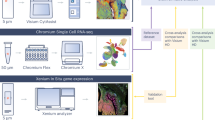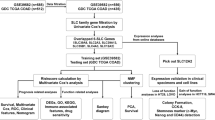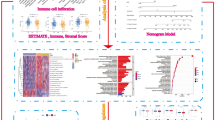Abstract
Aim:
To test the hypothesis that Cl− channel blockers affect T cell proliferation through Ca2+-release-activated Ca2+ (CRAC) signaling and examine the effects of the combination of a CRAC channel blocker and a Cl− channel blocker on concanavalin A (ConA; 5 mg/mL)-induced Ca2+ signaling, gene expression and cellular proliferation in human peripheral T lymphocytes.
Methods:
[3H]Thymidine incorporation, Fura-2 fluorescent probe, RNase protection assay, and reverse transcription-polymerase chain reaction were used.
Results:
The Cl− channel blocker 4,4′-diisothiocyanostilbene-2,2′-disulfonic acid (DIDS) inhibited ConA-induced Ca2+ influx, interleukin-2 mRNA expression and T lymphocyte proliferation in a concentration-dependent manner, and also enhanced the inhibitory effects of 1-{beta-[3-(4-methoxyphenyl)propoxyl]-4-methoxyphenethyl}-1H-imida-zole (SK&F96365) on the above key events during T cell activation. A combination of DIDS (1 μmol/L) and SK&F96365 (1 μmol/L) significantly diminished ConA-induced ClC-3 mRNA expression by 64%, whereas DIDS(1 μmol/L) or SK&F96365 (1 μmol/L) alone decreased ConA-induced ClC-3 mRNA expression by only 16% and 9%, respectively.
Conclusion:
These results suggest that there is an interaction between CRAC-mediated Ca2+ signaling and DIDS-sensitive Cl− channels during ConA-induced T cell activation and proliferation. Moreover, the DIDS-sensitive Cl− channels may be related to the ClC-3 Cl− channels.
Similar content being viewed by others
Article PDF
References
Gardner P . Calcium and T lymphocyte activation. Cell 1989; 59: 15–20.
Lewis RS . Calcium signaling mechanisms in T lymphocytes. Annu Rev Immunol 2001; 19: 497–521.
Premack BA, McDonald TV, Gardner P . Activation of Ca2+ current in Jurkat T cells following the depletion of Ca2+ stores by microsomal Ca2+-ATPase inhibitors. J Immunol 1994; 152: 5226–40.
Chung SC, McDonald TV, Gardner P . Inhibition by SK&F96365 of Ca2+ current, IL-2 production and activation in T lymphocytes. Br J Pharmacol 1994; 113: 861–8.
Zweifach A, Lewis RS . Mitogen-regulated Ca2+ current of T lymphocytes is activated by depletion of intracellular Ca2+ stores. Proc Natl Acad Sci USA 1993; 90: 6295–9.
Sarkadi B, Tordai A, Homolya L, Scharff O, Gardos G . Calcium influx and intracellular calcium release in anti-CD3 antibody-stimulated and thapsigargin-treated human T lymphoblasts. J Membr Biol 1991; 123: 9–21.
Partiseti M, Le Deist F, Hivroz C, Fischer A, Korn H, Choquet D . The calcium current activated by T cell receptor and store depletion in human lymphocytes is absent in a primary immunodeficiency. J Biol Chem 1994; 269: 32327–35.
Fanger CM, Hoth M, Crabtree GR, Lewis RS . Characterization of T cell mutants with defects in capacitative calcium entry: genetic evidence for the physiological roles of CRAC channels. J Cell Biol 1995; 131: 655–67.
Rouzaire-Dubois B, Milandri JB, Bostel S, Dubois JM . Control of cell proliferation by cell volume alterations in rat C6 glioma cells. Pflugers Arch 2000; 440: 881–8.
Voets T, Szucs G, Droogmans G, Nilius B . Blockers of volume-activated Cl− currents inhibit endothelial cell proliferation. Pflugers Arch 1995; 431: 132–4.
Wondergem R, Gong W, Monen SH, Dooley SN, Gonce JL, Conner TD, et al. Blocking swelling-activated chloride current inhibits mouse liver cell proliferation. J Physiol 2001; 532: 661–72.
Wang GL, Wang XR, Lin MJ, He H, Lan XJ, Guan YY . Defi ciency in ClC-3 chloride channels prevents rat aortic smooth muscle cell proliferation. Circ Res 2002; 91: E28–32.
Xiao GN, Guan YY, He H . Effects of Cl− channel blockers on endothelin-1-induced proliferation of rat vascular smooth muscle cells. Life Sci 2002; 70: 2233–41.
Dai YP, Bongalon S, Hatton WJ, Hume JR, Yamboliev IA . ClC-3 chloride channel is upregulated by hypertrophy and inflammation in rat and canine pulmonary artery. Br J Pharmacol 2005; 145: 5–14.
Qian Y, Guan YY, Wang GL, Yang XR, He H, Qiu QY . Effects of ClC-3 antisense oligonucleotide on ConA induced T lymphocyte proliferation. Chin Pharmacol Bull 2004; 20: 314–7.
Qian Y, Guan YY, Wang GL, Yang XR, He H, Qiu QY . Relation ship between ConA induced T lymphocyte proliferation and ClC-3 protein. Chin Pharmacol Bull 2003; 19: 1132–5.
Jiang B, Hattori N, Liu B, Nakayama Y, Kitagawa K, Inagaki C . Suppression of cell proliferation with induction of p21 by Cl− channel blockers in human leukemic cells. Eur J Pharmacol 2004; 488: 27–34.
Wang GL, Guan YY, Wang B . Effects of chloride-channel blockers on T lymphocyte proliferation. Chin Pharmacol Bull 1999; 15: 146–9.
Phipps DJ, Branch DR, Schlichter LC . Chloride-channel block inhibits T lymphocyte activation and signalling. Cell Signal 1996; 8: 141–9.
Hess SD, Oortgiesen M, Cahalan MD . Calcium oscillations in human T and natural killer cells depend upon membrane poten tial and calcium influx. J Immunol 1993; 150: 2620–33.
Feske S, Giltnane J, Dolmetsch R, Staudt LM, Rao A . Gene regulation mediated by calcium signals in T lymphocytes. Nat Immunol 2001; 2: 316–24.
Lewis RS, Cahalan MD . Mitogen-induced oscillations of cytosolic Ca2+ and transmembrane Ca2+ current in human leukemic T cells. Cell Regul 1989; 1: 99–112.
Merritt JE, Armstrong WP, Benham CD, Hallam TJ, Jacob R, Jaxa-Chamiec A, et al. SK&F 96365, a novel inhibitor of receptor-mediated calcium entry. Biochem J 1990; 271: 515–22.
Tao L, Guan YY, He H, Han C, Zhang YY, Sun JJ . Comparison of the Ca2+ movement by activation of alpha1-adrenoceptor sub types in HEK-293 cells. Life Sci 1997; 61: 2127–36.
Chomczynski P, Sacchi N . Single-step method of RNA isolation by acid guanidinium thiocyanate-phenol-chloroform extraction. Anal Biochem 1987; 162: 156–9.
Jiang B, Hattori N, Liu B, Kitagawa K, Inagaki C . Expression of swelling-and/or pH-regulated chloride channels (ClC-2, 3, 4 and 5) in human leukemic and normal immune cells. Life Sci 2002; 70: 1383–94.
Britton FC, Ohya S, Horowitz B, Greenwood IA . Comparison of the properties of CLCA1 generated currents and Icl(Ca) in murine portal vein smooth muscle cells. J Physiol 2002; 539: 107–17.
Lewis RS, Ross PE, Cahalan MD . Chloride channels activated by osmotic stress in T lymphocytes. J Gen Physiol 1993; 101: 801–26.
Crabtree GR, Clipstone NA . Signal transmission between the plasma membrane and nucleus of T lymphocytes. Annu Rev Biochem 1994; 63: 1045–83.
Zuckerman LA, Pullen L, Miller J . Functional consequences of costimulation by ICAM-1 on IL-2 gene expression and T cell activation. J Immunol 1998; 160: 3259–68.
Takahashi N, Wang X, Tanabe S, Uramoto H, Jishage K, Uchida S, et al. ClC-3-independent sensitivity of apoptosis to Cl− channel blockers in mouse cardiomyocytes. Cell Physiol Biochem 2005; 15: 263–70.
Zhang H, Zhou JG, Qiu QY, Ren JL, Guan YY . ClC-3 chloride channel prevents apoptosis induced by thapsigargin in PC 12 cells. Apoptosis 2006; 11: in press.
Dietrich J, Lindau M . Chloride channels in mast cells: block by DIDS and role in exocytosis. J Gen Physiol 1994; 104: 1099–11.
Duan D, Winter C, Cowley S, Hume JR, Horowitz B . Molecular identification of a volume-regulated chloride channel. Nature 1997; 390: 417–21.
Hermoso M, Satterwhite CM, Andrade YN, Hidalgo J, Wilson SM, Horowitz B, et al. ClC-3 is a fundamental molecular component of volume-sensitive outwardly rectifying Cl− channels and volume regulation in HeLa cells and Xenopus laevis oocytes. J Biol Chem 2002; 277: 40066–74.
Sardini A, Amey JS, Weylandt KH, Nobles M, Valverde MA, Higgins CF . Cell volume regulation and swelling-activated chloride channels. Biochim Biophys Acta 2003; 1618: 153–62.
Kerschbaum HH, Negulescu PA, Cahalan MD . Ion channels, Ca2+ signaling, and reporter gene expression in antigen-specific mouse T cells. J Immunol 1997; 159: 1628–38.
Sipido KR, Callewaert G, Carmeliet E . [Ca2+]i transients and [Ca2+]i-dependent chloride current in single Purkinje cells from rabbit heart. J Physiol 1993; 468: 641–67.
Verkerk AO, Schumacher CA, Van Ginneken AC, Veldkamp MW, Ravesloot JH . Role of Ca2+-activted Cl− current in ventricular action potentials of sheep during adrenoceptor stimulation. Exp Physiol 2001; 86: 151–9.
Schumacher PA, Sakellaropoulos G, Phipps DJ, Schlichter LC . Small-conductance chloride channels in human peripheral T lymphocytes. J Membr Biol 1995; 145: 217–32.
Author information
Authors and Affiliations
Corresponding author
Additional information
Project supported by the National Natural Science Foundation of China (No 30271503 and No 30472021), Science Foundation of the Ministry of Education in China and China Medical Board (No 00730).
Rights and permissions
About this article
Cite this article
Wang, Gl., Qian, Y., Qiu, Qy. et al. Interaction between Cl− channels and CRAC-related Ca2+ signaling during T lymphocyte activation and proliferation. Acta Pharmacol Sin 27, 437–446 (2006). https://doi.org/10.1111/j.1745-7254.2006.00297.x
Received:
Accepted:
Issue Date:
DOI: https://doi.org/10.1111/j.1745-7254.2006.00297.x
Keywords
This article is cited by
-
NKILA lncRNA promotes tumor immune evasion by sensitizing T cells to activation-induced cell death
Nature Immunology (2018)



